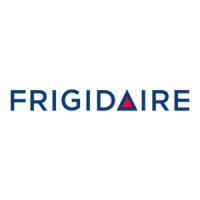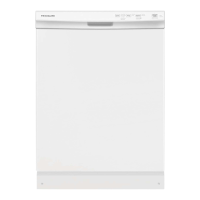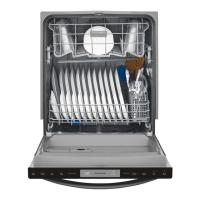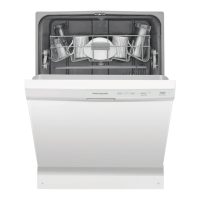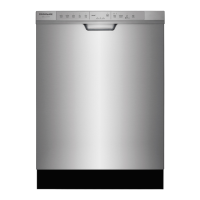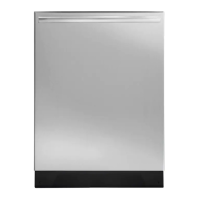Do you have a question about the Frigidaire LFBD2409LM0B and is the answer not in the manual?
Explains the HI-TEMP WASH option, its temperature, and effect on cleaning and drying.
Details the HEAT DRY option for enhanced drying performance and its energy cost.
Describes the DELAY START option for automatic delayed dishwasher start times.
Explains how to lock and unlock dishwasher controls to prevent accidental changes.
Details how to load various items like cups, glasses, and stemware into the upper rack.
Explains how to load plates, bowls, and cookware in the lower rack for optimal cleaning.
Provides guidance on loading silverware, including safety precautions and mixing items.
Instructions on how to add or remove items during a wash cycle.
Explains how to fill the detergent dispenser with covered and uncovered cups.
Guides on the amount of detergent based on water hardness, measured in grains per gallon.
Explains the function of rinse aid, how to use the dispenser, and troubleshooting spots.
Details the required water pressure range (20-120 psi) for optimal dishwasher operation.
States the need for hot water (at least 120°F/49°C) for effective cleaning and drying.
Guide for cleaning the dishwasher's exterior, interior, and specific components like the filter.
Instructions for cleaning the overfill protector to prevent overfilling.
Steps to prepare the dishwasher for freezing temperatures, including disconnection and restoration.
Troubleshooting tips for food residue remaining on dishes after a wash cycle.
Solutions for dishes not drying properly, including rinse aid and water temperature checks.
Addresses issues of spotting and cloudiness on glassware and flatware.
Advice on preventing chipping of dishes and glassware during loading and operation.
Explains causes and solutions for staining and discoloration of dishware.
Discusses etching on glassware caused by excessive detergent or low water temperature.
Tips for when detergent remains in the dispenser cups after the cycle.
Troubleshooting steps for identifying and resolving dishwasher leaks.
Explains that water vapor escaping the vent during drying is normal.
Describes the typical sounds associated with the dishwasher's operation.
Addresses the issue of water remaining in the tub after a cycle, indicating drainage problems.
Troubleshooting steps for when the dishwasher fails to start or operate.
Diagnoses for the dishwasher not filling with water, checking supply and overfill protector.
Steps to resolve drainage issues, including checking the disposer and drain hose.
Examines reasons why a dishwasher cycle might be taking longer than usual.
Solutions for common odors, including new unit smell and issues with drainage.
Addresses staining on the tub interior, often caused by tomato-based soils.
Instructions for removing hard water buildup, spots, and film from dishes and interior.
Explains the HI-TEMP WASH option, its temperature, and effect on cleaning and drying.
Details the HEAT DRY option for enhanced drying performance and its energy cost.
Describes the DELAY START option for automatic delayed dishwasher start times.
Explains how to lock and unlock dishwasher controls to prevent accidental changes.
Details how to load various items like cups, glasses, and stemware into the upper rack.
Explains how to load plates, bowls, and cookware in the lower rack for optimal cleaning.
Provides guidance on loading silverware, including safety precautions and mixing items.
Instructions on how to add or remove items during a wash cycle.
Explains how to fill the detergent dispenser with covered and uncovered cups.
Guides on the amount of detergent based on water hardness, measured in grains per gallon.
Explains the function of rinse aid, how to use the dispenser, and troubleshooting spots.
Details the required water pressure range (20-120 psi) for optimal dishwasher operation.
States the need for hot water (at least 120°F/49°C) for effective cleaning and drying.
Guide for cleaning the dishwasher's exterior, interior, and specific components like the filter.
Instructions for cleaning the overfill protector to prevent overfilling.
Steps to prepare the dishwasher for freezing temperatures, including disconnection and restoration.
Troubleshooting tips for food residue remaining on dishes after a wash cycle.
Solutions for dishes not drying properly, including rinse aid and water temperature checks.
Addresses issues of spotting and cloudiness on glassware and flatware.
Advice on preventing chipping of dishes and glassware during loading and operation.
Explains causes and solutions for staining and discoloration of dishware.
Discusses etching on glassware caused by excessive detergent or low water temperature.
Tips for when detergent remains in the dispenser cups after the cycle.
Troubleshooting steps for identifying and resolving dishwasher leaks.
Explains that water vapor escaping the vent during drying is normal.
Describes the typical sounds associated with the dishwasher's operation.
Addresses the issue of water remaining in the tub after a cycle, indicating drainage problems.
Troubleshooting steps for when the dishwasher fails to start or operate.
Diagnoses for the dishwasher not filling with water, checking supply and overfill protector.
Steps to resolve drainage issues, including checking the disposer and drain hose.
Examines reasons why a dishwasher cycle might be taking longer than usual.
Solutions for common odors, including new unit smell and issues with drainage.
Addresses staining on the tub interior, often caused by tomato-based soils.
Instructions for removing hard water buildup, spots, and film from dishes and interior.
| Brand | Frigidaire |
|---|---|
| Model | LFBD2409LM0B |
| Type | Built-In |
| Capacity | 14 Place Settings |
| Control Type | Electronic |
| Drying System | Heated Dry |
| Energy Star Certified | Yes |
| Soil Sensor | Yes |
| Delay Start | Yes |
| Third Rack | Yes |
| Stainless Steel Interior | Yes |
| Wash Cycles | 4 |
| Width | 24 in |
| Height | 35 Inches |
